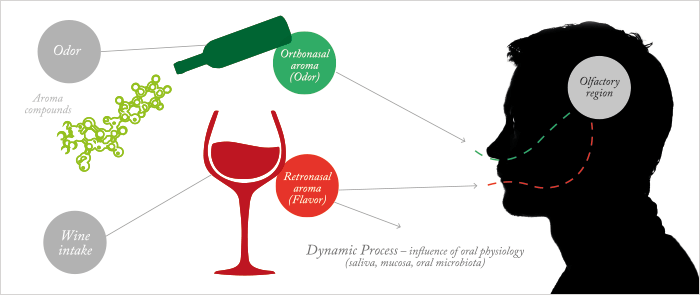
Victoria Moreno-Arribas, of the Institute of Food Science Research (CIAL), Madrid, was aware that studies regarding aroma release during wine consumption were scarce, and also that there was little research on the role of different oral factors – saliva, oral mucosa and, in particular, the composition of oral microbiota – in aroma release during wine drinking. To that end, she embarked upon research to fill the gap – and discovered that flavor release may depend of the type of bacteria present in the mouth, something that is subject to large inter-individual variability.
Within a global research project dealing with the role of human physiology on wine aroma release and aroma perception during wine consumption conditions by using different in vitro or in vivo approaches, Moreno-Arribas’ aim was to evaluate the ability of bacteria present in the oral cavity to hydrolyze grape glycosidic precursors and release the corresponding aromatic compounds (“aglycones”). The final goal was to determine if inter-individual variations in the composition and metabolic activity of oral microbiota could affect wine flavor release. There were several stages to the research. “In a first in vitro experiment, the effect of nine representative bacteria species from oral microbiota was evaluated in terms of the biotransformation of glycosidic aroma precursors into the corresponding odorant components,” Moreno-Arribas explains. “Subsequently, the same experimental procedure was performed, but using the whole human oral microbiota isolated from saliva of healthy volunteers (ex vivo).” To isolate and extract the odorant aglycones, samples from both trials were processed by head-space solid phase microextraction and then analyzed by gas chromatography mass spectrometry (GC-MS). Though many factors are involved in our appreciation of fermented grape juice, the research gives a clearer indication of what factors affect individual enjoyment. “The results indicate the influence of oral microbiota on how aroma compounds are released in the mouth ,” says Moreno-Arribas. “However, other physiological factors, such as saliva, oral mucosa, breathing, together with other sensory experiences, such as taste, texture and color, all play a part in flavor perception and come together to explain why the same food tastes very different from one individual to another.” But what does this mean for our enduring love of wine? Moreno-Arribas believes it may make choosing that bottle of red a lot easier: “We are still a way away, but in the future it may be possible that by analyzing your saliva, your nasal mucosa and the composition of bacteria that make up your oral microbiota, you can find out which wine is likely to provide you with more pleasure – one which your palate, your nose and your brain will enjoy the most. I hope we can get to that point one day.” On the other hand, you could just try before you buy...




